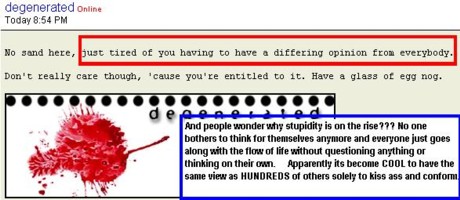near the bottom...look for bob vila, he can help

<br>

Yeah...thanks....I have the Ecotec engine and it has a pipe going into the Fuel Pressure Regulator...what do I do about that?
<br>
<a href=http://www.cardomain.com/memberpage/499831</a><img src="http://images.cardomain.com/member_images/7/web/499000-499999/499831_7.jpg"></a>
if its a vaccum line then reinstall a nipple into the pipe and recconect the vaccum line... <br>

Thanks...IT WORKED!!!

<br>
<a href=http://www.cardomain.com/memberpage/499831</a><img src="http://images.cardomain.com/member_images/7/web/499000-499999/499831_7.jpg"></a>
ok i got a newbie? can explain some gauges u can get....ex. air fuel and such....just curious on what all they read....
thanks
<B>TYPICAL GAUGES</B>
<b>A/F Ratio</b> The air/fuel ration gauge indicates whether your air/fuel mixture ratio is rich or lean. It's particularly helpful tuning tool if your engine is carbureted instead of fuel injected. Most a/f ratio gauges work with the existing oxygen sensor, according to the manufacturers, but how old is the existing o2 sensor? O2 sensors become "lazy" before they actually fail. Lazy o2 sensors might still work, but if it's signal is intermittent, irregular, or slow (which it probably is if it's the original unit on a 10-year old car), replace it. Or install another o2 sensor that's dedicated to the a/f ratio gauge.
<b>ammeter</b> an ammeter tells you how much current your alternator is putting out. Ammeters are not as popular s the once were, most use voltmeters instead.
<b>boost gauge</b> a boost gauge indicates the boost pressure on a supercharged or turbocharged engine. This is not an option on these vehicles. An over-boost condition caused by a stuck waste-gate can cause serious damage.
<b>coolant temp gauge</b> the coolant temperature gauge indicates the temperature of the engine coolant. you might already have a coolant temp gauge; if you're going to replace it, you'll need to consult the manufacturer to determine whether your new gauge will work with the existing sender for the old gauge. If you want to add a coolant temp gauge - and you don't already have one, you'll need to install a coolant temp. sending unit. Also keep in mind that on many modern vehicles, a single engine coolant temp (ECT) sensor, which is the info sensor for the PCM, also functions as the coolant temp sending unit for the coolant temp gauge. On these models you might want to install another sender dedicated to your new coolant temp gauge.
<b>cylinder head temp gauge</b> A cylinder head temp gauge tells you the temp of the cylinder head (duh!), but it's real value is that it can provide you with a general idea of the engine's operating temperature. For example, it can indicate whether an engine overheats under full power, or whether it has a tendency to run too cold, just right or too hot over a longer period. You will need to install a new sender for cylinder head temperature gauge because this type of gauge is rarely found on cars as original equipment.
<b>Exhaust gas temperature (EGT) gauge</b>. An EGT gauge tells you the temp of the exhaust gases as they're exiting the combustion chamber. An EGT of 1100 to 1200F should result in nice tan colored spark plug electrodes. A lower reading should produce darker colored plugs, and higher readings should give you gray or white plugs. Once you've identified the "normal" temperature range that produces tan plugs, all you have to do is monitor the EGT gauge and watch for any deviation from normal. An EGT gauge is a valuable tuning tool when you're trying to set up the correct mixture ration. A lean mixture will run hotter than normal, while a rich mixture will run cooler than normal (and will actually make increasingly less horsepower as it gets richer). An EGT can also help you identify "hot spots" which can occur when chopping the throttle from a full-throttle situation.
<b>fuel pressure gauge</b> a NA high performance engine, an engine equipped with nitrous oxide or a supercharged or turbocharged engine makes big demands on the fuel delivery system under acceleration, so you need a heavy-duty fuel pump capable of supplying sufficient fuel. And you need a fuel pressure gauge to make sure that the fuel pressure is adequate under all conditions. A fuel system that fails to deliver sufficient fuel under acceleration or high speed running leans out the a/f mixture ration, which leads to detonation (very bad) or pre-ignition conditions which can ruin a motor in seconds. The fuel pressure gauge is primarily used for tuning. One reason for this is that you can't install it inside the car; you wouldn't want high pressure fuel spraying the inside of the car if a compression fitting came loose!
<b>nitrous gauge</b> if you're running nitrous oxide, you need to know how much nitrous is in the tank. Running out of nitrous in the middle of a drag race will cause your a/f mixture to turn really rich in a hurry, which could cause big troubles. If you're going to install a nitrous kit, make sure you have a gauge to monitor the level in the tank.
<b> oil pressure gauge</b> The oil pressure gauge tells you the pressure of the engine oil. If you don't have an oil pressure gauge, this is one of the first gauges you should consider installing. An oil pressure gauge can save your engine from some expensive damage. If the engine looses oil pressure because of a pump failure or a blocked oil passage, oil pressure will drop suddenly; w/out an oil pressure gauge, you might very well run the engine until it destroys itself. Many after market oil pressure gauges can work with the existing oil pressure sending unit.
<b>oil temp gauge</b> the oil temp gauge tells you the temperature of the engine oil, which is generally considered a more accurate way of monitoring engine temperatures.
<b>shift light</b> a shift light is a large, bright LED that can be programmed to come on at a specific, predetermined rpm level. You don't have to take your eyes off the road to watch a shift light; because of its intensity, a shift light can be seen out of the corner of your eye. A shift light can be located on the face of a special after market drag racing tach or housed in a separate enclosure mounted on top of the dash.
<b> tach</b> the tachometer tells you the engine speed in rpms. Some after market tachs are also equipped with shift lights. Some of the top-of-the-line units even make a recording of each run (or even multiple runs) so that you can analyze the data afterwords.
<b>voltmeter</b> the voltmeter tells you the voltage output of your alternator.
Well, there's some very basic info about some gauges you can get...hope it helps.
<br>

and keep in mind, I typed this very quickly, and spell check doesn't pick up on words that are spelled right, but are wrong context.
Example, in the beginning, it should be obviously <i>air/fuel ratio gauge</i>
<br>

good info on gauges, but what is the water temp gauge good for...
and what is better in what cases... mechanical or electrical
<br>
-----------------------------------------------------------------------------
Imports better know they drive on the roads we built....
water temp/ coolant temp gives you a more accurate number than a sweep guage, you get a numerical value
also electrical i would say is better cause mechanical you can have leaks when dealing with psi and fluids...
leaks in the car...
electrical you add a sending unit and wires go in the car. <br>

To--
General Schwag (Event)
Hay man, see you got a new handle!!!.....good to see some familiar people on the thread.
Been out of the country for four months. Seems like forever.
Quote:
i see why we have so many clueless here now
I see you're still fighting the fight. lol

good quote out of that last article
Quote:
To correctly modify the head of an OBDII-equipped engine, close attention must be applied to keep the overall port volume small. No huge, tunnel-like ports here. Since simply increasing the overall diameter of the port is out, careful re-contouring of the port to improve flow without sacrificing velocity is essential. More flow can be picked up through the careful re-cutting of the valves and valve seats without risking error code triggering.
<br>

I didn't see the answer to this anywhere, but if it is there I appologize.
How often should I clean/replace the filter on my short ram intake?
filters are good to be replaced for up to 50k, or as directed... HOWEVER, as k7n claims, the more accumulation the better it filters, but that also means the less air flows by...
with a reuseable guaze filter, atleast for myself, i clean one (i rotate between 5 filters now, since i gave one away to a 350Z) every 6000 miles, or every other oil change as you would replace the stock one.
this applies to any filter.
cleaner filters flow better.

<br>

event i was thinking you should add a part about what you need to re-do your head's and bottom end. kinda like a list for the people who are about to get head work done what parts they should replace, part #'s and a few good place's to look for them.
the past few weeks alot of people been asking about head workand doing the bottom end. <br>

Damn there is a lot of good info here. The only question I had that isnt addressed is what effect rain water would have on an intake with a SS style hood or worse a hood like mine that has two ports up front. I havent gotten a intake because I thought I wouldnt be sucking rain water into the intake once it gets soaked. Am I out of my mind or kinda right?

I was reading JBO and noticed all of these FAQs spread all over the place. I want to create a whole website full of these useful FAQs. I would like your permission to copy your FAQ onto this website(its not created yet). You will get credit and I will send you a copy before it goes live so you can make sure you like the layout and the infomation and all. If you would agree to this I would be very thankful as Im sure the j-body community would too.
We already have a "FAQ" but the interface isn't complete for me to upload the rest of it.... it's on the menu bar to the left.
If you're volunteering, you can help me upload it all when Dave readies the interface

...j <br>
<br><br><a href="http://www.j-body.org/members/jlenko/cars/3/"><img src="http://members.shaw.ca/johnz24/images/nov30sig.jpg"></a>
well, the FAQ up now is general info on j-bodies. Im talking about a FAQ based on say what a port and polish job is or What kind of paint to use to paint your interior panels? If your planning something like that then yeah sure I'll help you. IS that like what you had in mind?
Yup!
The FAQ that is up now is only about 1/25th of what I have to upload... check out the OLD FAQ in the library to get an idea..
...j <br>
<br><br><a href="http://www.j-body.org/members/jlenko/cars/3/"><img src="http://members.shaw.ca/johnz24/images/nov30sig.jpg"></a>

















